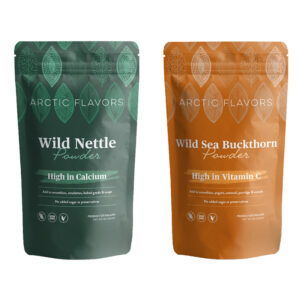Nettle, also called stinging nettle is a wild herb many people know little about. People mostly know it for its stinging character, but not so much for its other surprising facts. This blog post will reveal all you need to know about nettle, a nutritious wild herb of nature. Specifically, we will cover its origin, how it looks and tastes, its nutritional value and health benefits, how to use it, and where to find it.
What is nettle?
Nettle (urtica dioica) is wild herb. It is commonly known also as the stinging nettle or nettle leave. The nettle family has six subspecies, most of which have hollow stinging hairs. When they touch skin, they create a stinging or burning sensation. Nettle has been used as a medicine, as well as for tea and food for centuries.
Where does nettle come from?
Nettle is originally from Europe, cooler regions of Asia, and western North Africa. Nowadays, it can be found worldwide, the most abundant places being Northern countries such as Finland, Sweden, Norway, Canada, and the United States. Nettle grows in various environments, often in the countryside and on the sides of roads. Nettle grows in various climates and it adjusts well to different temperatures. It typically grows from spring to fall, but not in the winter.
How does nettle look?
Nettle plants can reach up to 1 to 2 meters (3 to 7 feet). The soft leaves are usually 3 to 15 cm (1 to 16 inches) long. The color of the stem and the leaves are deep green when they are young and a darker green when they get older. The plant also has yellow flowers, also called rhizomes.
Can you eat nettles?
Yes, you can definitely eat nettle, and it is actually very nutritious and versatile for cooking. If you have fresh nettles, you should prepare it with the following easy steps before cooking:
- Quickly rinse them with cold water to clean it from any soil, leaves, bugs.
- Put them in boiling water for a few minutes, to break the stinging hairs of the nettles.
- Drain the water out and squeeze any excess water out of the nettles.
What part of nettles can you eat?
You can eat the stem and the leaves of nettles, but do not eat the roots. The taste of nettle tends to get bitter and the texture fibery as they mature, so it is also recommended to pick young nettles or the small leaves of mature nettles.
How does nettle taste?
Nettle has a herbaceous and rich taste. It tastes a bit like spinach, but more grassy and earthy.
What are the health benefits of nettle?
Nettle is very rich in various healthy nutrients. It is an excellent source of calcium, iron, magnesium, and selenium. Amazingly, it has 3-4 times more calcium than milk (per 100g), and double the amount of iron and magnesium as spinach.
How do you use nettles?
There are endless ways to use nettle! Some of the easiest ways are:
- Use it like you would spinach or kale for pasta, casseroles, soups, omelets, etc.
- Add it to your smoothies and shakes
- Make delicious nettle tea
Visit some delicious nettle-based green smoothie recipes: green booster smoothie with wild nettle and super green powder smoothie.
Where can I find nettle?
If you are lucky and live in a place where nettle grows wild, you can find them in nature. However, only pick it from clean and unpolluted places. Avoid nettles next to roads due to emissions. Picking nettles close to farmlands and barns is not a good idea either, as the nettles may have an increased amount of harmful nitrate ions.
On the other hand, nettle powder is available all year round, regardless of where you live. This is the easiest way to get the amazing health benefits of nettle by adding it to your daily diet. Nettle powder is made by drying the fresh nettles immediately after picking and then powdering them. It can be stored at room temperature, and it stays fresh for six months after opening a package. You can use it just like you would use fresh nettle – in plates of pasta, soups, casseroles, salads, smoothies, omelets, etc.
Arctic Flavors’ 100% natural nettle powder is made of nettle only. We add no sugar, colorants, or preservatives. It is 100% nettle! Ten grams of the nettle powder equals about 70 grams of fresh nettle, so a spoonful of nettle powder is equal to a handful of fresh nettle.
You may also like:
- Nettle Powder 85g19,95 €
- Green Smoothie Booster36,95 €
If you have any questions or comments on nettle, please reach out to us on our social media channels:
Thanks for reading!
xx
Arctic Flavors



